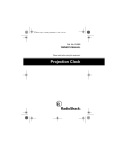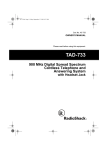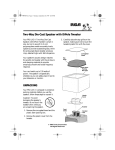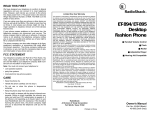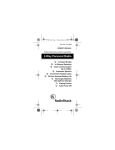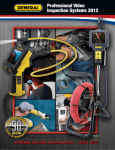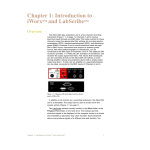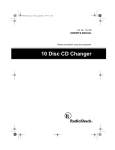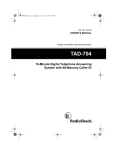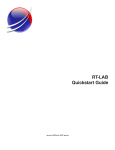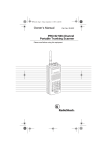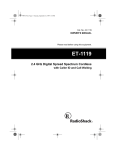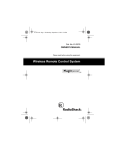Download 24-Range LCD Digital Multimeter
Transcript
Cat. No. 22-805 OWNER’S MANUAL Please read before using this equipment. 24-Range LCD Digital Multimeter FEATURES Your RadioShack 24-Range LCD Digital Multimeter is a portable compact multimeter that is ideal for field, lab, shop, bench, and home applications. Its 33/4-digit digital display means it can display up to 3,999 units. The meter measures DC and AC current up to 20 A, voltage up to 1000V DC and 750V AC, and resistance up to 40 MΩ. Important: • Completely read this manual before you use the meter. • If you are not familiar with multimeters and testing procedures, we suggest you read the book Using Your Meter (available at your local RadioShack store) before you use this meter. Here are some features that make your new multimeter a real pro: Computer Interface and Software — lets you connect your meter to your PC-compatible computer with the supplied MSDOS or Microsoft Windows 3.1, 95, or 98 software, so you can log and graph measurements. Data Hold Function — the meter holds the displayed value, so you can see the reading even after you disconnect the probes. Analog Bargraph Display — indicates the magnitude of the input compared to the full-scale value of the measurement range. Overload and Transient Protection — helps protect the meter from overvoltage in most ranges. © 1999 Tandy Corporation. All Rights Reserved. RadioShack is a registered trademark used by Tandy Corporation. 2 Auto-Polarity Operation — protects your meter and gives valid measurements even when you connect the leads in reverse polarity. Auto Power Off — conserves battery power by sounding a beep then turning off the meter if you do not change any settings for 15 minutes. Low-Battery Indicator — so you can quickly see when you need to replace the batteries. UL Listed — your meter has passed the stringent safety tests required by Underwriters Laboratories. Note: The UL mark does not indicate that this product has been evaluated by Underwriters Laboratories for the accuracy of its readings. Continuity Buzzer Function — lets you quickly hear if there is continuity in a cable or between two points. Diode Check Function — lets you safely check semiconductors for open, shorted, or normal junctions. Latest IC and Display Technology — ensure reliability, accuracy, stability, and ease of operation. Note: Your multimeter requires one 9V battery (not supplied). 3 CONTENTS A Word About Safety ......................................................................................................................................................... 6 Special Panel Markings .................................................................................................................................................... 8 Specifications .................................................................................................................................................................... 9 DC Volts (Max Measurement: 1000V) .......................................................................................................................... 9 AC Volts (Max Measurement: 750 V) ........................................................................................................................... 9 DC Current (Max Measurement: 20 A) ........................................................................................................................ 9 AC Current (Max Measurement: 20 A) ......................................................................................................................... 9 Resistance ................................................................................................................................................................. 10 Continuity Test ............................................................................................................................................................ 10 Diode Test .................................................................................................................................................................. 10 Communication .......................................................................................................................................................... 10 Miscellaneous ............................................................................................................................................................ 11 Preparation ...................................................................................................................................................................... Installing a Battery ..................................................................................................................................................... Connecting the Test Leads ......................................................................................................................................... Using the Stand ......................................................................................................................................................... 12 12 14 14 Using the Meter ............................................................................................................................................................... Measuring High-Voltage Circuits ................................................................................................................................ Overrange Indication .................................................................................................................................................. Using Display Hold ..................................................................................................................................................... Using Range Hold ...................................................................................................................................................... 15 16 16 17 17 4 Making Measurements .................................................................................................................................................... 18 Measuring DC/AC Voltage .......................................................................................................................................... 18 Measuring Three-Phase AC Voltage .......................................................................................................................... 19 Measuring Current ...................................................................................................................................................... 19 Measuring Resistance ................................................................................................................................................ 21 Checking Continuity .................................................................................................................................................... 22 Checking Diodes ........................................................................................................................................................ 23 Checking Diode Polarity ...................................................................................................................................... 25 Using the Meter With a Computer .................................................................................................................................. 26 Connecting the Meter to a Computer ......................................................................................................................... 26 Using the Supplied Software ...................................................................................................................................... 26 Using the DOS Software ..................................................................................................................................... 27 Using the Windows Software .............................................................................................................................. 28 Technical Information .................................................................................................................................................. 29 Communication Parameters ................................................................................................................................ 29 Data Format ........................................................................................................................................................ 29 Hints for Writing Your Own Software .......................................................................................................................... 30 Care and Maintenance ..................................................................................................................................................... 31 Cleaning ..................................................................................................................................................................... 32 Replacing the Fuses ................................................................................................................................................... 32 The FCC Wants You to Know ..................................................................................................................................... 35 5 A WORD ABOUT SAFETY We have taken every precaution in designing this meter to ensure that it is as safe as we can make it. But safe operation depends on you, the operator. We recommend that you follow these simple safety rules: • Never apply voltages to the meter that exceed the limits given in the specifications. Never apply more than 1000V DC or 750V RMS AC between the input jacks and ground. • Use extreme caution when working with voltages above 30V AC or 60V DC. Always disconnect power from the circuit you are measuring before you connect test leads to high-voltage points. • Never connect the test leads to a source of voltage when you select the diode check, resistance measurement, continuity measurement, or current measurement functions. • Always discharge any capacitors of the circuit under test before you attach test leads. • Always turn off power and disconnect the test leads from the circuit you are testing before you replace the meter’s battery or fuse. • Never operate the meter unless its back cover is in place and fully closed. • This equipment is rated for installation category II (maximum 3600 VA). • Because many AC/DC sets have a potentially hot chassis, be sure the top of your workbench and the floor underneath it are made of non-conductive materials. This meter is fully calibrated and tested. Under normal use, no further adjustment should be necessary except as noted in this Owner’s Manual. If the meter requires repair, do not try to adjust it yourself. Take it to your local RadioShack store. 6 WARNINGS: • USE EXTREME CAUTION IN THE USE OF THIS DEVICE. IMPROPER USE OF THIS DEVICE CAN RESULT IN INJURY OR DEATH. FOLLOW ALL SAFEGUARDS SUGGESTED IN THIS OWNER’S MANUAL IN ADDITION TO NORMAL SAFETY PRECAUTIONS IN DEALING WITH ELECTRICAL CIRCUITS. DO NOT USE THIS DEVICE IF YOU ARE UNFAMILIAR WITH ELECTRICAL CIRCUITS AND TESTING PROCEDURES. • NEVER TRY TO PROBE WITH BOTH TEST LEADS AT THE SAME TIME OR HOLD BOTH TEST LEADS IN ONE HAND. • IF THIS EQUIPMENT IS USED IN A MANNER NOT SPECIFIED BY THE MANUFACTURER, THE PROTECTION PROVIDED BY THE EQUIPMENT MAY BE IMPAIRED. • TO REDUCE THE RISK OF FIRE OR SHOCK HAZARD, DO NOT EXPOSE THIS PRODUCT TO RAIN OR MOISTURE. • FOR INDOOR USE ONLY. 7 SPECIAL PANEL MARKINGS For your safety, we have added special markings to the meter’s panel to remind you of the measurement limitations. 20 A The maximum current that you can measure at this terminal is 20 amps. 500V MAX To avoid electrical shock or instrument damage, do not connect the common input terminal (–COM jack) to any source that exceeds 500 volts with respect to earth/ground. 400mA MAX The maximum current that you can measure at this terminal is 400 milliamps. ! Caution: Risk of electric shock! Refer to the complete operating instructions. 1000V 750V The maximum voltage that this meter can measure is 1000V DC or 750V AC. MAX Caution: Be extra careful when making high-voltage measurements; DO NOT TOUCH TERMINALS OR PROBE ENDS. The meter is protected by double insulation. CAT II 8 This equipment is rated for installation category II (max. 3600 VA). SPECIFICATIONS DC VOLTS (MAX MEASUREMENT: 1000V) 400 mV/4–40–400 V/1000 V .............................................................. ±0.5% of reading, ±0.3% of full scale, ±3 in last digit AC VOLTS (MAX MEASUREMENT: 750 V) 400 mV/4–40–400 V ........................................................................... ±1.2% of reading, ±0.8% of full scale, ±5 in last digit 750 V .................................................................................................. ±1.5% of reading, ±1.2% of full scale, ±5 in last digit DC CURRENT (MAX MEASUREMENT: 20 A) 4 mA ................................................................................................... ±1.0% of reading, ±0.5% of full scale, ±3 in last digit 400 mA ............................................................................................... ±1.5% of reading, ±1.2% of full scale, ±3 in last digit 20 A .................................................................................................... ±2.5% of reading, ±2.0% of full scale, ±5 in last digit AC CURRENT (MAX MEASUREMENT: 20 A) 4 mA ................................................................................................... ±1.5% of reading, ±1.0% of full scale, ±5 in last digit 400 mA ............................................................................................... ±2.0% of reading, ±1.5% of full scale, ±5 in last digit 20 A .................................................................................................... ±3.5% of reading, ±3.0% of full scale, ±5 in last digit 9 RESISTANCE 400 Ω/4/40/400 KΩ/4 MΩ .................................................................... ±1.0% of reading, ±0.5% of full scale, ±3 in last digit 40 MΩ ................................................................................................. ±3.5% of reading, ±3.0% of full scale, ±5 in last digit CONTINUITY TEST The continuity buzzer sounds at less than 50 Ω. DIODE TEST The diode test measures whether a semiconductor is open, shorted, or normal. COMMUNICATION Transmission Rate ................................................................................................................................................. 600 baud Character Coding ................................................................................................................................................. 7-bit ASCII Parity Bit ....................................................................................................................................................................... None Stop Bits .............................................................................................................................................................................. 2 Interface ........................................................................................................................................................... RS232 Serial 10 MISCELLANEOUS Display ........................................................................................................................... LCD 33/4-digit maximum, bargraph Range Selection .................................................................................................................. Auto or manual range selection Polarity ....................................................................................................................................... Automatic polarity selection Input Impedance ................................................................................................................. 10 MΩ at DCV and ACV ranges Low Battery Indicator ............................................... appears when battery voltage drops below operating voltage of 3.0 V Overrange Indication ................................................... OL (overload) appears, the bargraph flashes, and the meter beeps Operating Temperature .................................................................................................................... 32 to 104°F (0 to 40°C) Storage Temperature ................................................................................................................... 14 to 122°F (–20 to 60°C) Power Source ............................................................................................................................................... One 9V battery Dimensions (HWD) ......................................................................................................................... 11/3 × 36/16 × 73/7 Inches (34 × 81 × 187 mm) Weight (without batteries) ........................................................................................................................... 12.35 oz (350 g) Included Accessories ............................................................................................................................................ Test leads Extra 2A 250V Ceramic Fuse RS232C Cable 3.5 inch floppy disk Specifications are typical; individual units might vary. Specifications are subject to change and improvement without notice. 11 PREPARATION INSTALLING A BATTERY Your meter requires one 9 volt battery (not supplied) for power. For the best performance and longest life, we recommend a RadioShack alkaline battery. Warnings: • To avoid electrical shock, disconnect both of the meter’s test leads from any equipment before you install or remove the meter’s battery. • Do not operate your meter until the battery is properly installed and the back cover is in place and secured. Cautions: • Use only a fresh battery of the required size and recommended type. • While the back cover is removed, do not touch any of the components inside the meter other than as noted in this Owner’s Manual. Doing so might damage the meter. Follow these steps to install the battery. 1. Turn off the meter if it is not already off, then disconnect the test leads if they are connected. 2. Use a Phillips screwdriver to remove the screw in the meter’s back cover and lift off the cover. Warning: Do not discard the supplied insulation capsule inside the meter. To avoid electrical shock or damage to your meter, install the battery properly in the capsule as shown in Step 3. 12 3. Place the battery into the insulation capsule then snap it onto the contacts. 4. Replace the battery compartment cover and secure it with the screw. When appears or the meter stops operating properly, replace the battery. Warning: Dispose of old batteries promptly and properly. Do not burn or bury them. Caution: If you do not plan to use the meter for a week or more, remove the battery. Batteries can leak chemicals that can destroy electronic parts. 13 CONNECTING THE TEST LEADS The test leads supplied with your meter are rated for 1200 volts. Use only test leads of the same rating with the meter. You can order replacement leads from your local RadioShack store. WARNING: ALTHOUGH THE TEST LEADS ARE RATED FOR 1200 VOLTS, THE MAXIMUM RATING OF THIS METER IS 1000 VOLTS DC/750 VOLTS RMS AC. DO NOT TRY TO MEASURE ANY VOLTAGE GREATER THAN 1000 VOLTS DC/750 VOLTS RMS AC. Plug the black test lead’s right-angled end into the meter’s COM (common) jack, then plug the red test lead’s right-angled end into the V/Ω jack. Caution: If the current in the circuit you are measuring is in the 20A DC/AC range or you do not know the amount of current in the circuit (see “Measuring Current” on Page 19), plug the red test lead’s right-angled end into the 20A jack instead of the V/Ω jack, to help prevent damage to the meter. USING THE STAND The fold-out stand on the back of the meter lets you place the meter upright on a flat surface (as shown here) for easier viewing. 14 USING THE METER Before you use your meter for the first time, follow these steps to familiarize yourself with its operation. Warning: Always turn off power to the circuit you are about to measure before you probe the test leads into high-voltage points. Caution: Be sure to select the correct function before you touch the test leads to the circuit or component to be tested. 1. Press ON/OFF to turn on the meter if it is not already on. The meter beeps and: • if the selector is set to brates itself. • if the selector is set to itself. 20 A V • if the selector is set to Ω , 400 mA , 4 mA , or V , and a numbered bar graph appears and the meter cali- , 20A , 400mA , or 4m A , AC and a numbered bar graph appears and the meter calibrates or , OL and two bar graphs (numbered and analog) appear. 2. Turn the selector to change between the meter’s functions and familiarize yourself with the displays. 3. Set the selector to Ω , then repeatedly press R-H until appears on the lower left corner of the display. 4. Touch the test leads together. The meter sounds a tone. Note: The display might show a phantom reading in some DC and AC voltage ranges when the test leads are not connected to a circuit. This is normal. The high input sensitivity produces a “wandering” effect. When you connect the test leads to a circuit, a real measurement appears. 15 MEASURING HIGH-VOLTAGE CIRCUITS When you use the meter to check a high-voltage circuit, do not try to position both test leads at once. Instead, use an insulated slip-on alligator clip (available at your local RadioShack store) to clamp one of the test leads to the neutral or ground lead of the circuit (usually a bare, green, or white lead in AC wiring circuits). Then probe for voltages using the other test lead. This helps prevent accidentally touching a hot wire, because you need to concentrate on only one test lead. OVERRANGE INDICATION The following appears when the voltage or amperage you are measuring exceeds the meter’s range. If this happens, disconnect the meter from the circuit you are measuring or change the meter’s measuring range. 16 USING DISPLAY HOLD Your meter’s display hold feature lets you hold the current reading on the meter’s display. Press D-H to hold all indications on the display. D-H (display hold) appears and the meter holds the measured value on the display even if you remove the test leads from the circuit. To cancel hold, press D-H again. D-H disappears. USING RANGE HOLD Your meter is preset to automatically set a constant measurement range for voltage or resistance you measure. The range hold feature lets you hold the current measurement range. To turn on range hold, press R-H. R-H (range hold) appears and the meter holds the current measurement range. Then repeatedly press R-H to increase or decrease the range. The displayed range changes as you press R-H. To cancel range hold, hold down R-H. R-H disappears. 17 MAKING MEASUREMENTS MEASURING DC/AC VOLTAGE Warnings: • Never clamp a test lead to a hot wire (usually red, black, or blue in AC wiring circuits). If one lead is clamped to a hot wire and you touch the meter’s other probe, you could receive an electric shock. • The maximum input limit for voltage measurement is 1000V DC or 750V AC (RMS). To avoid electrical shock and damage to the meter, never try to measure a DC voltage above 1000 volts or an AC voltage above 750 volts RMS. Follow these steps to measure AC or DC voltage. 1. Press ON/OFF to turn on the meter if it is not already on. 2. Set the selector to V to measure DC voltages or 4m V to measure AC voltages. 3. Touch the test leads to the circuit you want to test. • When you measure AC voltages, AC appears on the left side of the display and V or mV appear on the right side. • When you measure DC voltages, only V or mV appears on the right side of the display. Note: If the polarity of the voltage you are testing is negative, 18 appears on the left side of the display. MEASURING THREE-PHASE AC VOLTAGE We designed this meter primarily to measure household AC voltages. If you want to measure 3-phase, line-to-line voltages, please note the following: • Because of the dangers inherent in measuring three-phase circuits, we strongly recommend you do not use this meter for such applications. • The actual voltage can be greater than the circuit’s rated line-to-ground voltage. Most 3-phase power circuits are rated by their line-to-line voltage. This voltage is higher than the line (or phase) to ground voltage. To determine if a line-to-line 3-phase voltage exceeds the rating of this meter, multiply the rated line-to-ground voltage by 1.732 (the square root of 3). For example, if the rated line-to-ground voltage is 462 volts, the line-to-line voltage is 462 × 1.732 = 800 V AC. This voltage exceeds the meter’s rating. Therefore, you should not connect the meter to this circuit or to any equipment connected to the circuit. Doing so could present a dangerous shock hazard to you, and could also damage the meter. MEASURING CURRENT To measure AC or DC current, you must break the circuit and connect the test leads to two circuit connection points. The connection must be in series with the circuit under test. 19 Warning: The meter’s internal components might become dangerously hot if you measure current in the 20A DC/AC range. Make measurements within 30 seconds after you connect the meter to the circuit, and allow the meter to cool for 15 minutes between measurements. Cautions: • Never connect the test leads across a voltage source. Doing so can damage the meter or the circuit under test. The maximum input limit for AC/DC current measurement is 400 mA (if you connect the red test lead to mA) or 20 A (if you connect the red test lead to 20A). • If you do not know the amount of current in the circuit you are measuring, always set the selector to the red test lead to 20A. 20A and connect Follow these steps to measure AC or DC current. 1. Set the selector to 20 A , 400 mA , or 4 mA (to measure DC current) or 20A , 400mA , or 4m A (to measure AC current). 2. If you have not already done so, plug the red test lead’s right-angled end into 400 mA (if you are measuring 400 mA or less of current) or 20A (if you are measuring more than 400 mA of current). 3. Connect the meter’s test leads in series with the circuit. 4. Apply power and read the current. 20 Notes: • If you set the selector to 20 A , 400 mA , or appears on the left side of the display. 4 mA and the polarity of the voltage you are testing is negative, • The 20A range is fuse-protected. If the meter does not show a reading in this range, check the fuse (see “Replacing the Fuses” on Page 32). MEASURING RESISTANCE The resistance measuring circuit in your meter compares the voltage gained through a known resistance (internal) with the voltage developed across an unknown resistance. Warning: Be sure the circuit under test has all power removed and any associated capacitors are fully discharged before you make a resistance measurement. Follow these steps to measure resistance. 1. Remove all power from the circuit under test and discharge all capacitors. 2. Set the selector to Ω . Caution: Never connect the test leads to a source of voltage while the selector is set to Ω . 3. Touch the test leads across the circuit you want to measure, or remove one of the leads of the component you want to measure from its circuit and touch the test leads across the component. The resistance value appears. 21 Notes: • With no resistance connected across the test leads (meaning resistance is infinite), O.L appears when you set the meter to measure resistance. This is normal. • If you are measuring resistance of about 1 MΩ or more, the display might take a few seconds to stabilize. This is normal. • As with the voltage range, use the measuring units that appear on the display to determine the current resistance range. If only Ω appears, the values of the measurements are in ohms. If K and Ω appear, the meter is measuring kilohms (1 kilohm = 1000 Ω). If M and Ω appear, the meter is measuring megohms (1 megohm = 1,000,000 Ω). CHECKING CONTINUITY You can use the meter to check for shorted or open electrical circuits. 1. Remove all power from the circuit under test and discharge all capacitors. 2. Set the selector to Ω . Caution: Never connect the test leads to a source of voltage while the selector is set to Ω . 3. If you have not already done so, plug the black test lead’s right-angled end into COM and the red test lead’s rightangled end into the V/Ω jack. 22 4. Touch the test leads across the circuit you want to measure. The buzzer sounds if the circuit resistance is less than about 50 ohms (meaning the circuit is continuous or shorted). CHECKING DIODES This procedure lets you check diodes, transistors, and other semiconductors for opens, shorts, and normal operation. It also lets you determine the forward voltage and polarity for diodes. (This is handy when you need to match a diode.) You can also check LEDs using this procedure. Caution: Do not connect the test leads to a source of voltage with the selector set to the circuit being tested. . This could damage the meter or 1. Remove all power from the circuit under test and discharge all capacitors. 2. Set the selector to . 3. If you have not already done so, plug the black test lead’s right-angled end into COM and the red test lead’s rightangled end into the V/Ω jack. 23 4. Connect the test leads to the device you want to check, or remove one of the leads of the component you want to measure from its circuit and connect the test leads to the component. 5. Reverse the test leads and note the second reading. • If one reading shows a value and the other is overrange (OL appears), the device is good. • If OL appears during both readings, the device is open. • If both values are very small or zero, the device is shorted. Notes: • When you test a silicon-type semiconductor, the values might vary depending on the temperature. • The values that appear during a diode check show the actual forward voltage (max. 2.0V). If the voltage exceeds 2.0V, OL appears. This means the diode check cannot be made using this meter. 24 Checking Diode Polarity Many diodes have a stripe or mark on one side. The marked side of the diode indicates the diode’s cathode or negative (–) side. The other side is the anode or positive (+) side. Cathode Diode Anode + If a diode is not marked, you can use your meter to check the diode’s polarity. As you follow the steps under “Checking Diodes” on Page 23, connect the red test lead to one side, connect the black test lead to the other side, then measure and note the voltage. Then reverse the test leads and measure and note the second reading. The side of the diode where the meter shows a higher voltage using the red test lead is the anode (+) side. 25 USING THE METER WITH A COMPUTER You can connect your meter to an IBM® or compatible PC equipped with a serial port, using the industry-standard 9-pin D subminiature connector. CONNECTING THE METER TO A COMPUTER To connect the meter to your computer, open the RS-232C port cover on top of the meter, connect the supplied RS-232C cable between the meter’s and computer’s serial ports, then turn on the meter. USING THE SUPPLIED SOFTWARE We have supplied two programs with your meter to help you log and display data collected with your meter. The MS-DOS program is called RS, in the GRAPHIC subdirectory on the supplied 3.5 inch floppy disk. The Windows program is called Scopeview, in the SCOPE directory on the supplied floppy disk. 26 Using the DOS Software Notes: • Your computer must have a VGA monitor to use the supplied DOS software. • The following steps assume that a user has a basic knowledge of MS-DOS commands. Refer to your computer's MSDOS user's guide for information about MS-DOS commands. Follow these steps to install the driver from the supplied diskette. 1. Close all programs in use, then insert the supplied diskette into your computer’s floppy disk drive. 2. Create a directory on your hard drive for the software. For example, to make a directory called METER, type cd\ then press Enter. Then type md METER and press Enter. 3. Make the directory you created the current directory. For example, if the directory is METER, type cd\ METER at the DOS prompt then press Enter. 4. Copy the files from the GRAPHIC subdirectory on the floppy drive to your hard disk. For example, type copy a:\graphic c: then press Enter. 5. To run the program, type RS then press Enter. 6. Follow the instructions that appear. 27 Notes: • If you do not have a hard disk, you can still run the program from the supplied floppy diskette. Change to the GRAPHIC subdirectory on the diskette and type RS, then press Enter. • To stop the program or to escape from a device I/O error, press CTRL + BREAK. Using the Windows Software Notes: • Your computer must have Microsoft Windows 3.1 or later and a VGA or EGA monitor to use the Windows software. • The following steps assume that a user has a basic knowledge of Microsoft Windows. Refer to your computer's Windows user's guide for information about using Windows. • Refer to the README.TXT file in the SCOPE subdirectory included on the diskette for hints on operating your meter. • The following example shows how to use the Windows software using Windows 95. If you have Windows Version 3.1 or Windows 98, refer to the Windows user's guide for information about your version of Windows. 1. Close all programs in use, then insert the supplied diskette into your computer’s floppy disk drive. 2. From the Start Menu, select Run, type a:\scope\setup, then press Enter. 3. Follow the instructions that appear. To run the program, double-click the SCOPEVIEW icon. Follow the on screen help for specific operating instructions. 28 TECHNICAL INFORMATION You need the following information if you are writing your own interface software. Communication Parameters Transmission rate: 600 baud Character coding: 7-bit ASCII Parity: None Stop Bits: 2 Data Format The data format consists of a frame of 14 bytes. The frames are set as follows: BYTE) 123456789ABCDE Example 1) DC – 399 . 9 mV CR Example 2) OH 39 . 9 9 M o h m CR 29 HINTS FOR WRITING YOUR OWN SOFTWARE If you write your own program, the host computer must give the meter the D command to activate data transmission. The following code is an example of a BASIC program that gets a single reading from the meter: 10 OPEN "COM1 : 600,N,7,2,RS,CS,DS,CD" AS #2 20 A$="D" 30 PRINT #2,A$ 40 IN$=INPUT$(14,#2) 50 PRINT IN$ 60 CLOSE #2 70 END 30 CARE AND MAINTENANCE Your RadioShack 24-Range LCD Digital Multimeter is an example of superior design and craftsmanship. The following suggestions will help you care for your meter so you can enjoy it for years. Keep the meter dry. If it gets wet, wipe it dry immediately. Liquids might contain minerals that can corrode the electronic circuits. Use and store the meter only in normal temperature environments. Temperature extremes can shorten the life of electronic devices, damage batteries, and distort or melt plastic parts. Keep the meter away from dust and dirt, which can cause premature wear of parts. Handle the meter gently and carefully. Dropping it can damage circuit boards and cases and can cause the meter to work improperly. Use only fresh batteries of the required size and recommended type. Batteries can leak chemicals that damage your meter’s electronic parts. 31 Modifying or tampering with the meter’s internal components can cause a malfunction and might invalidate it’s warranty. If your meter is not performing as it should, take it to your local RadioShack dealer for assistance. CLEANING To keep the meter looking new, occasionally wipe it with a cloth slightly dampened with water. Do not use harsh chemicals, cleaning solvents, or strong detergents to clean the meter. Warnings: • Do not let any water drip inside the meter while cleaning it. • Make sure that the meter is completely dry before using it. REPLACING THE FUSES If the meter does not work, you might need to replace one of the fuses with the spare fuse (one 2A, 250V fast-acting fuse) we have included with your meter. Your meter has two fuses. Fuse F1 is a 2A, 250V ceramic fuse, and fuse F2 is a 15A, 250V fast-acting fuse (spare not supplied). Caution: Do not use fuses with ratings other than those specified here. Doing so might damage your meter. 32 Follow these steps to replace the fuses. 1. Turn the meter off if it is not already off, then disconnect the test leads if they are connected. Warning: To avoid electric shock, you must disconnect the test leads before you remove the back cover. 2. Lift the stand on the back of the meter and use a Phillips screwdriver to loosen the screws from the back cover, slide off the RS-232C port cover (on top of the meter), then lift off the cover. 3. The 2A, 250V ceramic fuse (F1) is on top of the circuit board next to the battery compartment. To remove it, gently pull it up. 4. If the fuse is blown, discard it. Then remove the spare fuse from beside the battery compartment and insert it into the fuse holder. 33 5. The 15A, 250V fast-acting fuse (F2) is underneath the circuit board next to the battery compartment. To remove it, gently lift up the circuit board until you can see the fuse, then gently pull it up. 6. If the fuse is blown, discard it. (You can get a new fuse at your local RadioShack store.) Then insert the new fuse into the fuse holder. 7. Replace the back cover and secure it with the screw. Warning: Do not operate your meter until the back cover is in place and secured. 34 THE FCC WANTS YOU TO KNOW This equipment complies with the limits for a Class B digital device as specified in Part 15 of FCC Rules. These limits provide reasonable protection against radio and TV interference in a residential area. However, your equipment might cause TV or radio interference even when it is operating properly. To eliminate interference, you can try one or more of the following corrective measures: • reorient or relocate the receiving antenna • increase the distance between the equipment and the radio or TV Consult your local RadioShack store if the problem still exists. You must use shielded interface cables with this equipment. This device complies with Part 15 of FCC Rules. Operation is subject to the following two conditions: (1) this device may not cause harmful interference, and (2) this device must accept any interference received, including any interference that may cause undesired operation. 35 Limited Ninety-Day Warranty This product is warranted by RadioShack against manufacturing defects in material and workmanship under normal use for ninety (90) days from the date of purchase from RadioShack company-owned stores and authorized RadioShack franchisees and dealers. EXCEPT AS PROVIDED HEREIN, RadioShack MAKES NO EXPRESS WARRANTIES AND ANY IMPLIED WARRANTIES, INCLUDING THOSE OF MERCHANTABILITY AND FITNESS FOR A PARTICULAR PURPOSE, ARE LIMITED IN DURATION TO THE DURATION OF THE WRITTEN LIMITED WARRANTIES CONTAINED HEREIN. EXCEPT AS PROVIDED HEREIN, RadioShack SHALL HAVE NO LIABILITY OR RESPONSIBILITY TO CUSTOMER OR ANY OTHER PERSON OR ENTITY WITH RESPECT TO ANY LIABILITY, LOSS OR DAMAGE CAUSED DIRECTLY OR INDIRECTLY BY USE OR PERFORMANCE OF THE PRODUCT OR ARISING OUT OF ANY BREACH OF THIS WARRANTY, INCLUDING, BUT NOT LIMITED TO, ANY DAMAGES RESULTING FROM INCONVENIENCE, LOSS OF TIME, DATA, PROPERTY, REVENUE, OR PROFIT OR ANY INDIRECT, SPECIAL, INCIDENTAL, OR CONSEQUENTIAL DAMAGES, EVEN IF RadioShack HAS BEEN ADVISED OF THE POSSIBILITY OF SUCH DAMAGES. Some states do not allow the limitations on how long an implied warranty lasts or the exclusion of incidental or consequential damages, so the above limitations or exclusions may not apply to you. In the event of a product defect during the warranty period, take the product and the RadioShack sales receipt as proof of purchase date to any RadioShack store. RadioShack will, at its option, unless otherwise provided by law: (a) correct the defect by product repair without charge for parts and labor; (b) replace the product with one of the same or similar design; or (c) refund the purchase price. All replaced parts and products, and products on which a refund is made, become the property of RadioShack. New or reconditioned parts and products may be used in the performance of warranty service. Repaired or replaced parts and products are warranted for the remainder of the original warranty period. You will be charged for repair or replacement of the product made after the expiration of the warranty period. This warranty does not cover: (a) damage or failure caused by or attributable to acts of God, abuse, accident, misuse, improper or abnormal usage, failure to follow instructions, improper installation or maintenance, alteration, lightning or other incidence of excess voltage or current; (b) any repairs other than those provided by a RadioShack Authorized Service Facility; (c) consumables such as fuses or batteries; (d) cosmetic damage; (e) transportation, shipping or insurance costs; or (f) costs of product removal, installation, set-up service adjustment or reinstallation. This warranty gives you specific legal rights, and you may also have other rights which vary from state to state. RadioShack Customer Relations, 200 Taylor Street, 6th Floor, Fort Worth, TX 76102 We Service What We Sell 04/99 RadioShack A Division of Tandy Corporation Fort Worth, Texas 76102 09A99 Printed in Korea




































